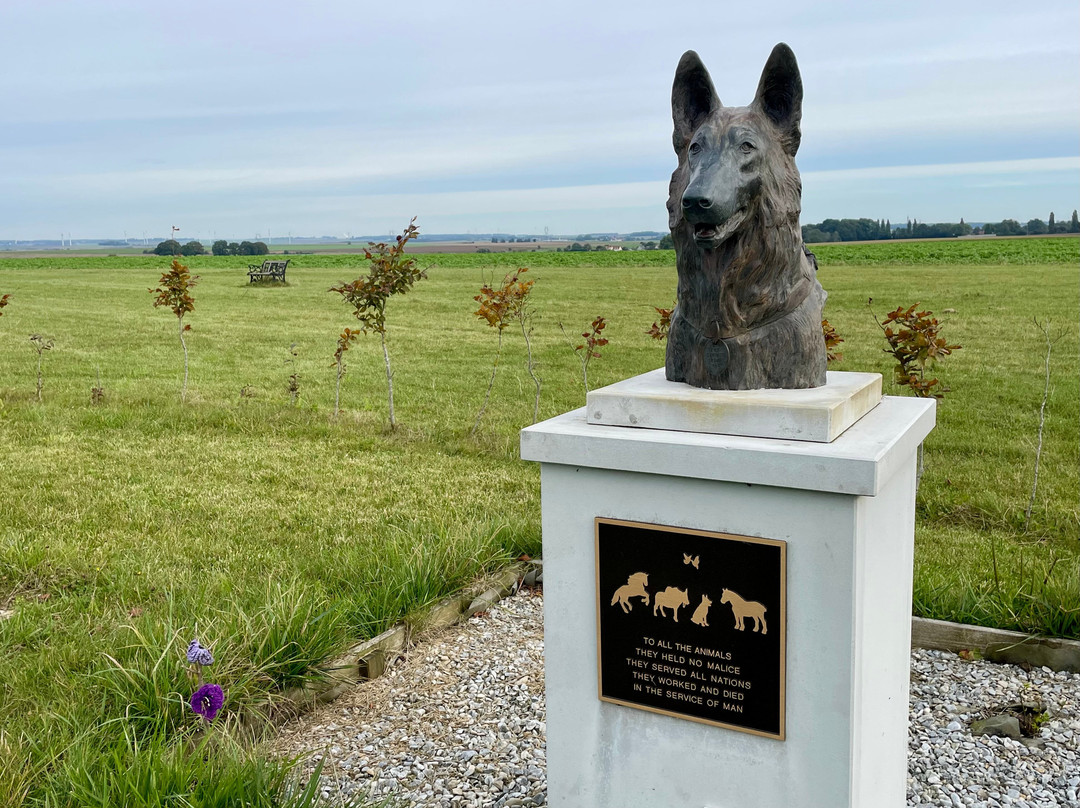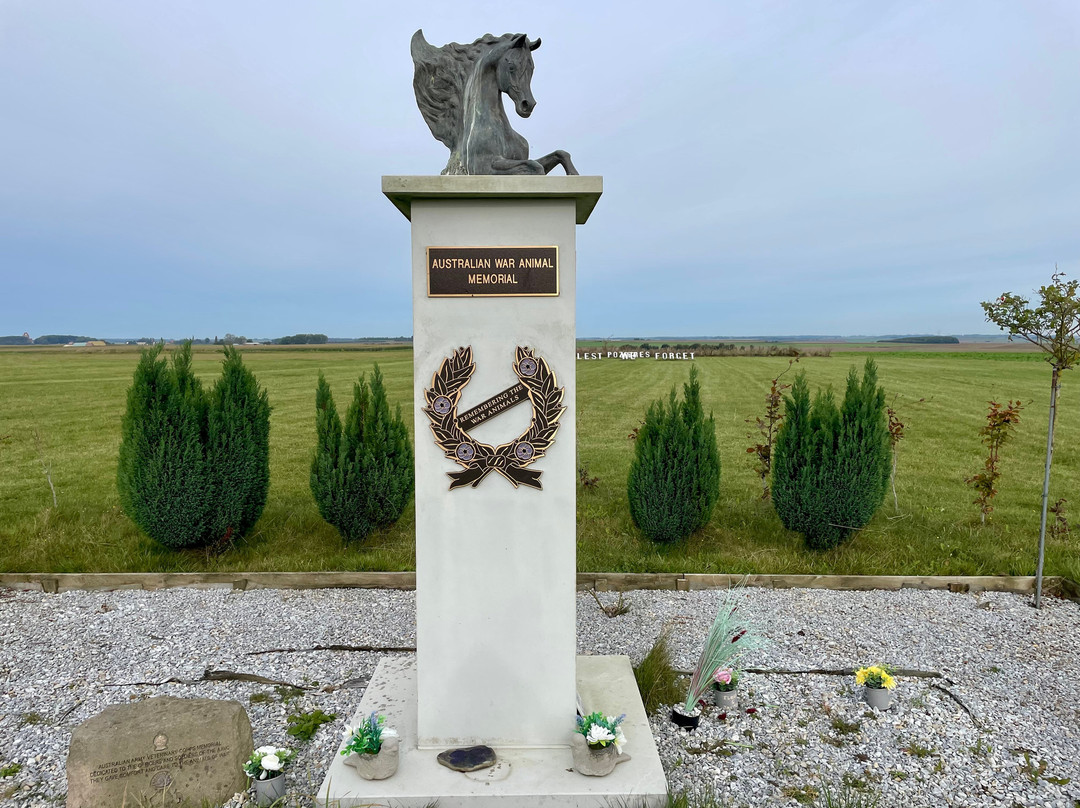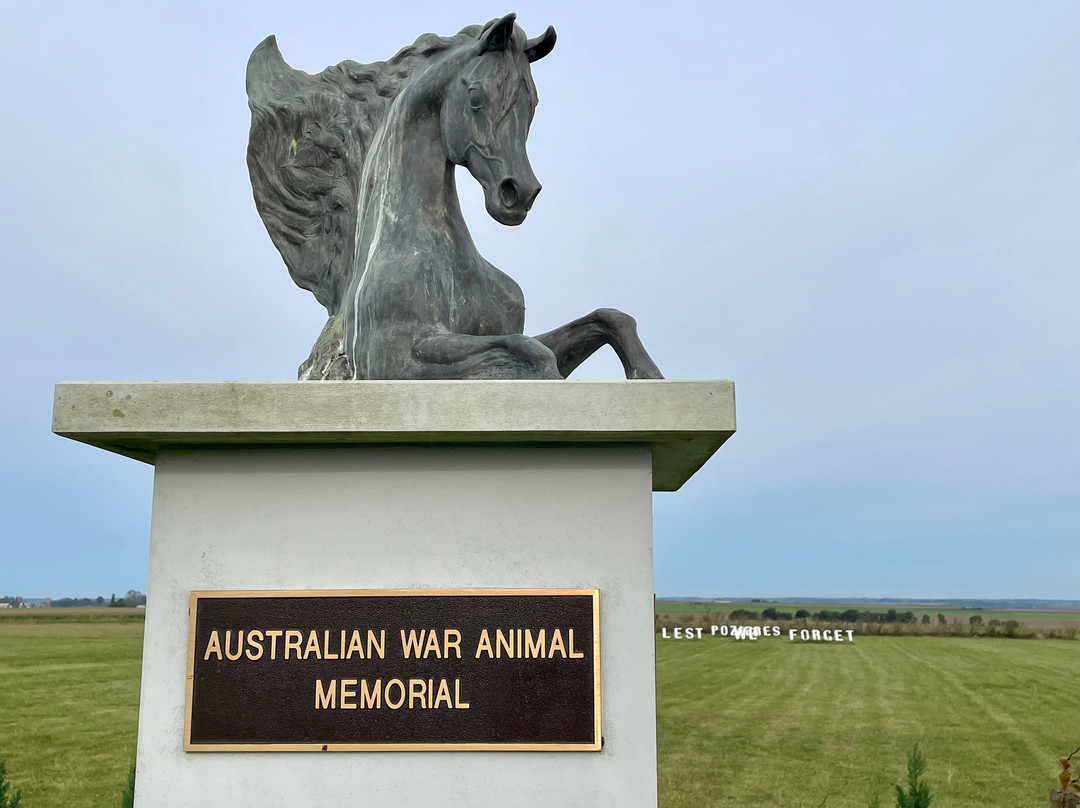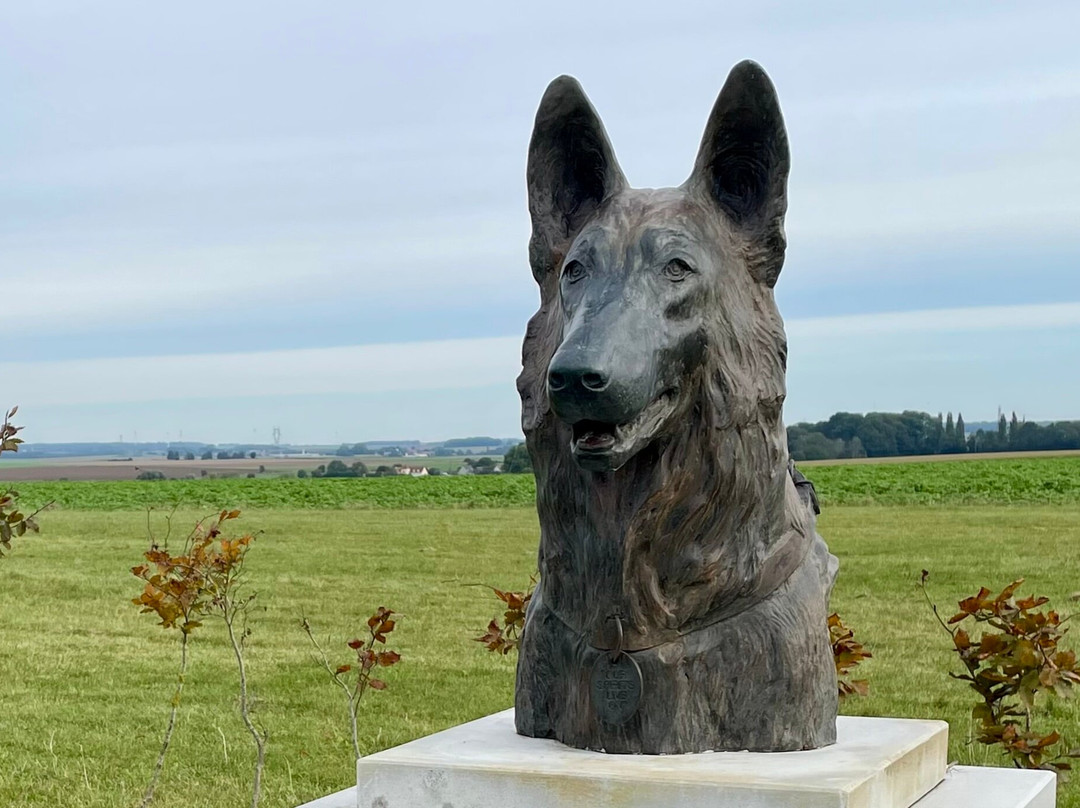的点评
"They Held No Malice, They Served All Nations”
WW1 Animal War Memorial的点评
点评:This small tribute to the millions of animals that served and died in WWI consists of two separate bronze sculptures - a horse and an Alsatian dog, eat on a small upright plinth.
Around 16 million animals ‘served’ in WWI -horses, dogs, pigeons, camels, donkeys and bullocks. Its estimated that about half died.
Horses and donkeys carried out vital transportation work. Trench dogs hunted out rats and acted as ‘ambulance dogs’, taking supplies to the wounded in no-man’s land. Pigeons, almost 100,000 of them, delivered messages behind enemy lines
The memorial is just a few minutes down the road from the large Pozieres Cemetery. You cant see it from the road because it is set back a little, just behind the famous Windmill Memorial site.
There are some moving passages on each memorial.
Mahatma Gandhi is quoted, ”The greatness of a nation and its moral progress
can be judged by the way its animals are treated.”
Another inscription reads, “To all the animals / they held no malice, they served all nations, they worked and died in the service of Man”
A tag around the dog's neck reads "Our Spirits Live On".
A plaque below the bronze horse’s head, also includes silhouettes of a Red Cross dog, a mule, a pigeon, and a donkey.
Around 16 million animals ‘served’ in WWI -horses, dogs, pigeons, camels, donkeys and bullocks. Its estimated that about half died.
Horses and donkeys carried out vital transportation work. Trench dogs hunted out rats and acted as ‘ambulance dogs’, taking supplies to the wounded in no-man’s land. Pigeons, almost 100,000 of them, delivered messages behind enemy lines
The memorial is just a few minutes down the road from the large Pozieres Cemetery. You cant see it from the road because it is set back a little, just behind the famous Windmill Memorial site.
There are some moving passages on each memorial.
Mahatma Gandhi is quoted, ”The greatness of a nation and its moral progress
can be judged by the way its animals are treated.”
Another inscription reads, “To all the animals / they held no malice, they served all nations, they worked and died in the service of Man”
A tag around the dog's neck reads "Our Spirits Live On".
A plaque below the bronze horse’s head, also includes silhouettes of a Red Cross dog, a mule, a pigeon, and a donkey.
翻译:这座小型纪念碑由两座独立的青铜雕塑组成,纪念在一战中服役和牺牲的数百万动物——一匹马和一只阿尔萨斯犬,它们在一个小型直立基座上进食。
大约有1600万只动物在一战中“服役”,包括马、狗、鸽子、骆驼、驴和公牛。据估计,其中约有一半死亡。
马和驴承担了重要的运输任务。战壕犬负责捕鼠,并充当“救护犬”,为无人区的伤员运送物资。近10万只鸽子负责在敌后传递信息。
纪念碑距离波济耶尔公墓仅几分钟车程。由于它位置稍靠后,就在著名的风车纪念碑遗址后面,所以从路上看不到它。
每座纪念碑上都有一些动人的段落。
圣雄甘地曾说过:“一个国家的伟大和道德进步,可以通过其对待动物的方式衡量。”
另一处铭文写道:“对所有动物/它们没有恶意,它们服务于所有国家,它们为人类服务而工作和牺牲。”
狗脖子上的标签上写着“我们的精神永存”。
铜马头下方的牌匾上,还有一只红十字犬、一头骡子、一只鸽子和一头驴子的轮廓。
大约有1600万只动物在一战中“服役”,包括马、狗、鸽子、骆驼、驴和公牛。据估计,其中约有一半死亡。
马和驴承担了重要的运输任务。战壕犬负责捕鼠,并充当“救护犬”,为无人区的伤员运送物资。近10万只鸽子负责在敌后传递信息。
纪念碑距离波济耶尔公墓仅几分钟车程。由于它位置稍靠后,就在著名的风车纪念碑遗址后面,所以从路上看不到它。
每座纪念碑上都有一些动人的段落。
圣雄甘地曾说过:“一个国家的伟大和道德进步,可以通过其对待动物的方式衡量。”
另一处铭文写道:“对所有动物/它们没有恶意,它们服务于所有国家,它们为人类服务而工作和牺牲。”
狗脖子上的标签上写着“我们的精神永存”。
铜马头下方的牌匾上,还有一只红十字犬、一头骡子、一只鸽子和一头驴子的轮廓。




此点评仅代表旅行者个人的主观意见,并不代表TripAdvisor以及其合作方的意见。
关于我们
|
新闻动态
|
商务合作
|
会员中心
|
业主中心
|
业主通
|
常见问题
|
意见反馈
|
联系我们
|
营业执照
© 2025 Tripadvisor 版权所有。
使用条款 |隐私政策 |网站工作原理
部分照片由 VFM Leonardo 提供。
* Tripadvisor不是旅行社,也不是旅游预订服务代理商。我们提供免费、客观、公正的旅游资讯服务。 (显示更多)
TripAdvisor LLC 既不是预订代理商,也不是旅游运营商,不会向网站用户收取任何服务费。 按照规定,在 Tripadvisor 发布机票价格、游览和旅行套餐的合作伙伴(航空公司、旅行提供商及预订代理商),其标价须包含所有费用和附加费用。 例如, 机场出入境税费、消费税与其他服务费、手续费、杂费及附加费用。 当您向我们的某个合作伙伴进行预订时,请务必查阅他们的网站以了解当地行政部门要求的所有适用费用的具体情况。 除非另有说明,机票价格通常指的是一个人的价格(以人民币计)。
为方便起见,TripAdvisor LLC 根据从我们的预订合作伙伴获取的空房率计算每个酒店的均价。 对于游览和景点来说,所显示价格通常是每位成人的最低可用价格。 对于列出的任何旅行套餐或优惠,TripAdvisor LLC 无法保证任何特定的费率或价格。 此外,酒店均价每晚会更新,并以您的首选币种表示(使用现行汇率)。 由于这些已换算的价格是预估价格,因此,有关具体金额和币种请与预订网站进行核实。
此外,TripAdvisor LLC 无法保证我们网站上宣传的价格随时有效。 标价可能需要预订一定天数才能生效,或有不可用日期、使用条件或限制。
TripAdvisor公司对外部网站的内容一概不负责。优惠价格中不含税和其他费用。
ICP证:沪B2-20200433
沪ICP备20013175号
 沪公网安备31010502005427号
沪公网安备31010502005427号鹰程信息技术(上海)有限公司
货币/国家及地区
¥CNY
中国

